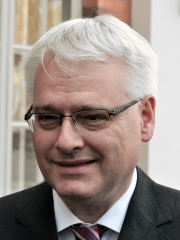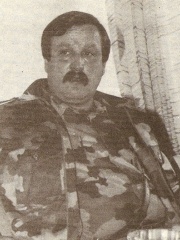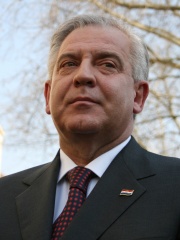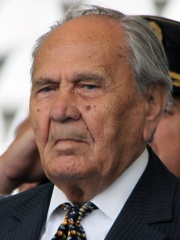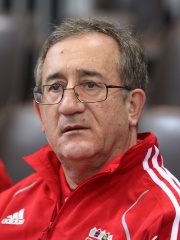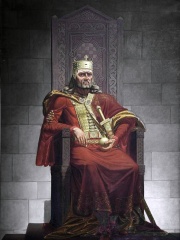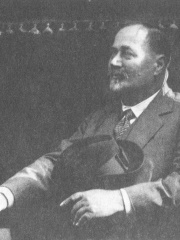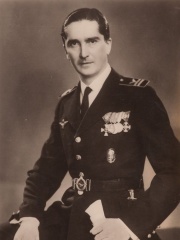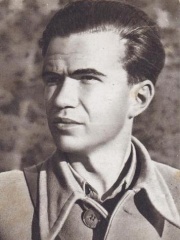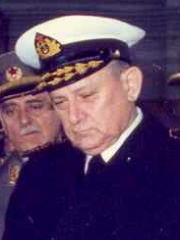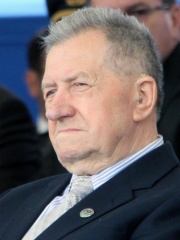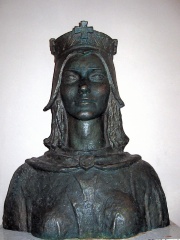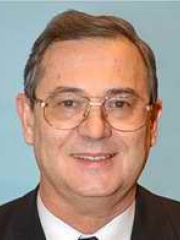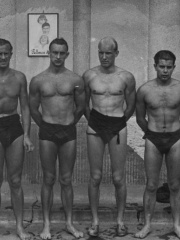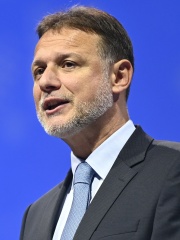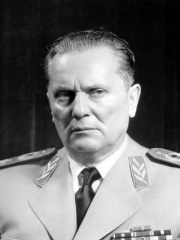
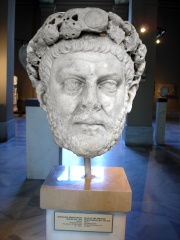
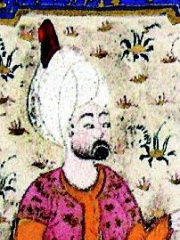
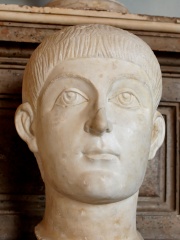
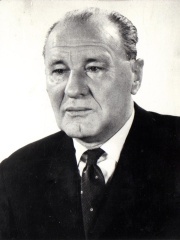
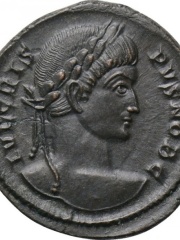
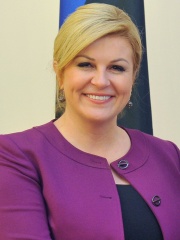
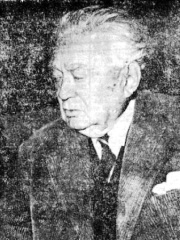
The Most Famous
POLITICIANS from Croatia
This page contains a list of the greatest Croatian Politicians. The pantheon dataset contains 19,576 Politicians, 61 of which were born in Croatia. This makes Croatia the birth place of the 46th most number of Politicians behind Ireland, and Vietnam.
Top 10
The following people are considered by Pantheon to be the top 10 most legendary Croatian Politicians of all time. This list of famous Croatian Politicians is sorted by HPI (Historical Popularity Index), a metric that aggregates information on a biography’s online popularity. Visit the rankings page to view the entire list of Croatian Politicians.

1. Josip Broz Tito (1892 - 1980)
With an HPI of 83.72, Josip Broz Tito is the most famous Croatian Politician. His biography has been translated into 105 different languages on wikipedia.
Josip Broz (Serbo-Croatian Cyrillic: Јосип Броз, pronounced [jǒsip brôːz] ; 7 May 1892 – 4 May 1980), commonly known as Tito (; Тито, pronounced [tîto]), was a Yugoslav communist revolutionary and politician who served in various positions of national leadership from 1943 until his death in 1980. During World War II, he led the Yugoslav Partisans, often regarded as the most effective resistance movement in German-occupied Europe. He also served as prime minister from 2 November 1944 to 29 June 1963 and president of the Socialist Federal Republic of Yugoslavia from 14 January 1953 until his death. His political ideology and policies are known as Titoism. Tito was born to a Croat father and a Slovene mother in Kumrovec in what was then Austria-Hungary. Drafted into military service, he distinguished himself, becoming the youngest sergeant major in the Austro-Hungarian Army of that time. After being seriously wounded and captured by the Russians during World War I, he was sent to a work camp in the Ural Mountains. Tito participated in some events of the Russian Revolution in 1917 and the subsequent Russian Civil War. Upon his return to the Balkans in 1920, he entered the newly established Kingdom of Yugoslavia, where he joined the Communist Party of Yugoslavia (KPJ). Having assumed de facto control over the party by 1937, Tito was formally elected its general secretary in 1939 and later its president, the title he held until his death. During World War II, after the Nazi invasion of the area, he led the Yugoslav guerrilla movement, the Partisans (1941–1945). By the end of the war, the Partisans, with the Allies' backing since mid-1943, took power in Yugoslavia. After the war, Tito was the chief architect of the Socialist Federal Republic of Yugoslavia (SFRY), serving as prime minister (1944–1963), president (1953–1980; since 1974 president for life), and marshal of Yugoslavia, the highest rank of the Yugoslav People's Army (JNA). Despite being one of the founders of the Cominform, he became the first Cominform member and the only leader in Joseph Stalin's lifetime to defy Soviet hegemony in the Eastern Bloc, leading to Yugoslavia's expulsion from the organisation in 1948 in what was known as the Tito–Stalin split. In the following years, alongside other political leaders and Marxist theorists such as Edvard Kardelj and Milovan Đilas, he initiated the idiosyncratic model of socialist self-management in which firms were managed by workers' councils and all workers were entitled to workplace democracy and equal share of profits. Tito wavered between supporting a centralised or more decentralised federation and ended up favouring the latter to keep ethnic tensions under control; thus, the constitution was gradually developed to delegate as much power as possible to each republic in keeping with the Marxist theory of withering away of the state. He envisaged the SFR of Yugoslavia as a "federal republic of equal nations and nationalities, freely united on the principle of brotherhood and unity in achieving specific and common interest." A very powerful cult of personality arose around him, which the League of Communists of Yugoslavia maintained even after his death. After Tito's death, Yugoslavia's leadership was transformed into an annually rotating presidency to give representation to all of its nationalities and prevent the emergence of an authoritarian leader. Twelve years later, as communism collapsed in Eastern Europe and ethnic tensions escalated, Yugoslavia dissolved and descended into a series of interethnic wars. Historians critical of Tito view his presidency as authoritarian and see him as a dictator, while others characterise him as a benevolent dictator. He was a popular public figure both in Yugoslavia and abroad. He remains a popular leader in the former countries of Yugoslavia. Tito was viewed as a unifying symbol, with his internal policies maintaining the peaceful coexistence of the nations of the Yugoslav federation. He gained further international attention as the founder of the Non-Aligned Movement, alongside Jawaharlal Nehru of India, Gamal Abdel Nasser of Egypt, Kwame Nkrumah of Ghana, and Sukarno of Indonesia. With a highly favourable reputation abroad in both Cold War blocs, he received a total of 98 foreign decorations, including the Legion of Honour and the Order of the Bath.

2. Diocletian (244 - 311)
With an HPI of 81.08, Diocletian is the 2nd most famous Croatian Politician. His biography has been translated into 85 different languages.
Diocletian (, DYE-ə-KLEE-shən; Latin: Gaius Aurelius Valerius Diocletianus, Ancient Greek: Διοκλητιανός, romanized: Diokletianós; 242/245 – 311/312), nicknamed Jovius, was Roman emperor from 284 until his abdication in 305. He was born Diocles to a family of low status in the Roman province of Dalmatia. Diocles rose through the ranks of the military early in his career, eventually becoming a cavalry commander for the army of Emperor Carus. After the deaths of Carus and his son Numerian on a campaign in Persia, Diocles was proclaimed emperor by the troops, taking the name Diocletianus. The title was also claimed by Carus's surviving son, Carinus, but Diocletian defeated him in the Battle of the Margus. Diocletian's reign stabilized the empire and ended the Crisis of the Third Century. He appointed fellow officer Maximian as Augustus, co-emperor, in 286. Diocletian reigned in the Eastern Empire, and Maximian reigned in the Western Empire. Diocletian delegated further on 1 March 293, appointing Galerius and Constantius as junior colleagues (each with the title Caesar), under himself and Maximian respectively. Under the Tetrarchy, or "rule of four", each tetrarch would rule over a quarter-division of the empire. Diocletian secured the empire's borders and purged it of all threats to his power. He defeated the Sarmatians and Carpi during several campaigns between 285 and 299, the Alamanni in 288, and usurpers in Egypt between 297 and 298. Galerius, aided by Diocletian, campaigned successfully against Persia, the empire's traditional enemy, and in 299, he sacked their capital, Ctesiphon. Diocletian led the subsequent negotiations and achieved a lasting and favorable peace. Diocletian separated and enlarged the empire's civil and military services and reorganized the empire's provincial divisions, establishing the largest and most bureaucratic government in the history of the empire. He established new administrative centers in Nicomedia, Mediolanum, Sirmium, and Trevorum, closer to the empire's frontiers than the traditional capital at Rome. Building on third-century trends towards absolutism, he styled himself an autocrat, elevating himself above the empire's masses with imposing forms of court ceremonies and architecture. Bureaucratic and military growth, constant campaigning, and construction projects increased the state's expenditures and necessitated a comprehensive tax reform. From at least 297 on, imperial taxation was standardized, made more equitable, and levied at generally higher rates. Not all of Diocletian's plans were successful: the Edict on Maximum Prices (301), his attempt to curb inflation via price controls, was counterproductive and quickly ignored. Although effective while he ruled, Diocletian's tetrarchic system collapsed after his abdication under the competing dynastic claims of Maxentius and Constantine, sons of Maximian and Constantius respectively. The Diocletianic Persecution (303–312), the empire's last, largest, and bloodiest official persecution of Christianity, failed to eliminate Christianity in the empire. After 324, Christianity became the empire's preferred religion under Constantine. Despite these failures and challenges, Diocletian's reforms fundamentally changed the structure of the Roman imperial government and helped stabilize the empire economically and militarily, enabling the empire to remain essentially intact for another 150 years despite being near the brink of collapse in Diocletian's youth. Weakened by illness, Diocletian left the imperial office on 1 May 305, becoming the first Roman emperor to abdicate the position voluntarily. He lived out his retirement in his palace on the Dalmatian coast, tending to his vegetable gardens. His palace eventually became the core of the modern-day city of Split in Croatia.

3. Rüstem Pasha (1500 - 1561)
With an HPI of 74.69, Rüstem Pasha is the 3rd most famous Croatian Politician. His biography has been translated into 36 different languages.
Rüstem Pasha (Turkish pronunciation: [ɾysˈtem paˈʃa]; Ottoman Turkish: رستم پاشا; c. 1505 – 10 July 1561) was an Ottoman statesman who served as Grand Vizier to Sultan Süleyman the Magnificent. Rüstem Pasha is also known as Damat Rüstem Pasha (the epithet damat meaning 'son-in-law' ) as a result of his marriage to the sultan's daughter, Mihrimah Sultan, in 1539. He is regarded as one of the most influential and successful grand viziers of the Ottoman Empire. Rustem Pasha was taken as a child to Constantinople (modern-day Istanbul), where he built a military and bureaucratic career under the protection of Hürrem Sultan, Süleyman's favorite and legal wife and Mihrimah's mother. His brother Sinan Pasha was an Ottoman grand admiral.

4. Valens (328 - 378)
With an HPI of 72.51, Valens is the 4th most famous Croatian Politician. His biography has been translated into 66 different languages.
Valens (Greek: Ουάλης, translit. Ouálēs; 328 – 9 August 378) was Roman emperor from 364 to 378. Following a largely unremarkable military career, he was named co-emperor by his elder brother Valentinian I, who gave him the eastern half of the Roman Empire to rule. In 378, Valens was defeated and killed at the Battle of Adrianople against the invading Goths, which astonished contemporaries and marked the beginning of barbarian encroachment into Roman territory. As emperor, Valens continually faced threats both internal and external. He defeated, after some dithering, the usurper Procopius in 366, and campaigned against the Goths across the Danube in 367 and 369. In the following years, Valens focused on the eastern frontier, where he faced the perennial threat of Persia, particularly in Armenia, as well as additional conflicts with the Saracens and Isaurians. Domestically, he inaugurated the Aqueduct of Valens in Constantinople, which was longer than all the aqueducts of Rome. In 376–77, the Gothic War broke out, following a mismanaged attempt to settle the Goths in the Balkans. Valens returned from the east to fight the Goths in person, but lack of coordination with his nephew, the western emperor Gratian (Valentinian I's son), as well as poor battle tactics, led to Valens and much of the eastern Roman army dying at a battle near Adrianople in 378. Although Valens is described as indecisive, impressionable, a mediocre general and overall "utterly undistinguished", he was nonetheless a conscientious and capable administrator, and a notable achievement of his was to significantly relieve the burden of taxation on the population. At the same time, his suspicious and fearful disposition, and excessive concern for personal safety, resulted in numerous treason trials and executions, which heavily stained his reputation. In religious matters, Valens favored a compromise between Nicene Christianity and the various non-trinitarian Christian sects, and interfered little in the affairs of the pagans.
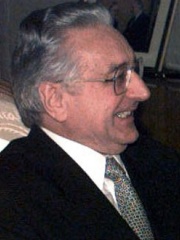
5. Franjo Tuđman (1922 - 1999)
With an HPI of 72.15, Franjo Tuđman is the 5th most famous Croatian Politician. His biography has been translated into 65 different languages.
Franjo Tuđman (Croatian pronunciation: [frǎːɲo tûdʑman]; 14 May 1922 – 10 December 1999) was a Croatian politician and historian who became the first president of Croatia, from 1990 until his death. He served following the country's independence from Yugoslavia. Tuđman also was the ninth and last president of the Presidency of SR Croatia from May to July 1990. Tuđman was born in Veliko Trgovišće. In his youth, he fought during World War II as a member of the Yugoslav Partisans. After the war, he took a post in the Ministry of Defence, later attaining the rank of major general of the Yugoslav Army in 1960. After his military career, he dedicated himself to the study of geopolitics. In 1963, he became a professor at the Zagreb Faculty of Political Sciences. He received a doctorate in history in 1965 and worked as a historian until coming into conflict with the regime. Tuđman participated in the Croatian Spring movement that called for reforms in the country and was imprisoned for his activities in 1972. He lived relatively anonymously in the following years until the end of communism, whereupon he began his political career by founding the Croatian Democratic Union (HDZ) in 1989. HDZ won the first Croatian parliamentary elections in 1990 and Tuđman became the President of the Presidency of SR Croatia. As president, Tuđman introduced a new constitution and pressed for the creation of an independent Croatia. On 19 May 1991, an independence referendum was held, which was approved by 93 percent of voters. Croatia declared independence from Yugoslavia on 25 June 1991. Areas with a Serb majority revolted, backed by the Yugoslav Army, and Tuđman led Croatia during its War of Independence. A ceasefire was signed in 1992, but the war had spread into Bosnia and Herzegovina, where Croats fought in an alliance with Bosniaks. Their cooperation fell apart in late 1992 and Tuđman's government sided with Herzeg-Bosnia during the Croat-Bosniak War, a move that brought criticism from the international community. In a final verdict of war crimes trial of former high-ranking officials of Herceg-Bosnia, the ICTY stated that Tuđman shared in their joint criminal enterprise goal of establishing an entity to reunite the Croatian people which was to be implemented through the ethnic cleansing of Bosnian Muslims. However, it did not find him guilty of any specific crimes. In March 1994, he signed the Washington Agreement with Bosnian President Alija Izetbegović that re-allied Croats and Bosniaks. In August 1995, he authorized a major offensive known as Operation Storm which effectively ended the war in Croatia. In the same year, he was one of the signatories of the Dayton Agreement that put an end to the Bosnian War. He was re-elected president in 1992 and 1997 and remained in power until his death in 1999. While supporters point out his role in achieving Croatian independence, critics have described his presidency as authoritarian. Surveys after Tuđman's death have generally shown a high favorability rating among the Croatian public.

6. János Kádár (1912 - 1989)
With an HPI of 70.37, János Kádár is the 6th most famous Croatian Politician. His biography has been translated into 58 different languages.
János József Kádár (; Hungarian: [ˈjaːnoʃ ˈkaːdaːr]; 26 May 1912 – 6 July 1989), born János József Czermanik, was a Hungarian Communist leader and the General Secretary of the Hungarian Socialist Workers' Party, a position he held for 32 years. Declining health led to his retirement in 1988, and he died in 1989 after being hospitalized for pneumonia.Kádár was born in Fiume in poverty to a single mother. After living in the countryside for some years, Kádár and his mother moved to Budapest. He joined the Party of Communists in Hungary's youth organization, KIMSZ, and went on to become a prominent figure in the pre-1939 Communist party, eventually becoming First Secretary. As a leader, he would dissolve the party and reorganize it as the Peace Party, but the new party failed to win much popular support. After World War II, with Soviet support, the Communist party took power in Hungary. Kádár rose through the party ranks, serving as Interior Minister from 1948 to 1950. In 1951, he was imprisoned by the government of Mátyás Rákosi but was released in 1954 by reformist Prime Minister Imre Nagy. On 25 October 1956, during the Hungarian Revolution, Kádár replaced Ernő Gerő as General Secretary of the Party, taking part in Nagy's revolutionary government. A week later, he broke with Nagy over his decision to withdraw from the Warsaw Pact. After Soviet intervention in Hungary, Kádár was selected to lead the country. He ordered Nagy to be executed shortly after coming to power. He gradually moderated, releasing the majority of remaining prisoners of this period in an amnesty in 1963. His leadership was characterized by unrelenting Realpolitik; for a long time, he successfully maneuvered between Moscow's wishes, local interests and the expectations of the Western world. In an interview with a Western journalist, he called himself a "toiler for compromise".Kádár was succeeded by Károly Grósz as General Secretary on 22 May 1988. Grósz would only serve a year in this post due to the fall of Communism in Europe in 1989. During his time as leader of Hungary, Kádár pushed for an improvement in standards of living. Kádár increased international trade with non-communist countries, in particular those of Western Europe. Kádár's policies differed from those of other Communist leaders, such as Nicolae Ceaușescu, Enver Hoxha, and Wojciech Jaruzelski, all of whom favored more orthodox interpretations of Marxism–Leninism. Kádár's reformist policies and the increasing commercial ties to the Western World would in turn worsen relations with Leonid Brezhnev in the Soviet Union. As the leader of Hungary, Kádár attempted to liberalize the Hungarian economy with a greater focus on consumer goods, in what would become known as Goulash Communism.

7. Crispus (305 - 326)
With an HPI of 65.07, Crispus is the 7th most famous Croatian Politician. His biography has been translated into 34 different languages.
Flavius Julius Crispus (; c. 300 – 326) was the eldest son of the Roman emperor Constantine I, as well as his junior colleague (caesar) from March 317 until his execution by his father in 326. The grandson of the augustus Constantius I, Crispus was the elder half-brother of the future augustus Constantine II and became co-caesar with him and with his cousin Licinius II at Serdica, part of the settlement ending the Cibalensean War between Constantine and his father's rival Licinius I. Crispus ruled from Augusta Treverorum (Trier) in Roman Gaul between 318 and 323 and defeated the navy of Licinius I at the Battle of the Hellespont in 324, which with the land Battle of Chrysopolis won by Constantine forced the resignation of Licinius and his son, leaving Constantine the sole augustus and the Constantinian dynasty in control of the entire empire. It is unclear what the legal status of the relationship Crispus's mother Minervina had with Constantine was; Crispus may have been an illegitimate son. Crispus's tutor in rhetoric was the Late Latin historian of Early Christianity Lactantius. After his elevation to imperial rank, at which point he was also entitled princeps iuventutis ("Prince of Youth"), the Latin rhetorician Nazarius composed a panegyric preserved in the Panegyrici Latini, which honoured Crispus's military victories over the Franks in c. 319. Crispus was three times Roman consul, for the years 318, 321, and 324. According to the Latin histories of Ammianus Marcellinus and Aurelius Victor, after a trial whose real circumstances are mysterious, Constantine executed Crispus at Pola (Pula) in 326. His stepmother Fausta was also put to death, and the Late Greek historian Zosimus and the Byzantine Greek writer Joannes Zonaras wrote that Constantine had accused Crispus of incest with her. After his death, Crispus was subjected to damnatio memoriae.

8. Kolinda Grabar-Kitarović (b. 1968)
With an HPI of 64.02, Kolinda Grabar-Kitarović is the 8th most famous Croatian Politician. Her biography has been translated into 94 different languages.
Kolinda Grabar-Kitarović (pronounced [ɡrǎbar kitǎːroʋitɕ] ; born 29 April 1968) is a Croatian politician and diplomat who served as President of Croatia from 2015 to 2020. She was the first woman to be elected to the office since the first multi-party elections in 1990 and independence from Yugoslavia in 1991. At 46 years of age, she also became the youngest person to assume the presidency.Before her election as President of Croatia, Grabar-Kitarović held a number of governmental and diplomatic posts. She was minister of European Affairs from 2003 to 2005, the first female minister of Foreign Affairs and European Integration from 2005 to 2008, Croatian ambassador to the United States from 2008 to 2011 and assistant secretary general for public diplomacy at NATO under Secretaries General Anders Fogh Rasmussen and Jens Stoltenberg from 2011 to 2014.She is a recipient of the Fulbright Lifetime Achievement Award and a number of national and international awards, decorations, honorary doctorates and honorary citizenships.Grabar-Kitarović was a member of the conservative Croatian Democratic Union party from 1993 to 2015 and was also one of three Croatian members of the Trilateral Commission, but she was required to resign both positions upon taking office as president in 2015, as Croatian presidents are not permitted to hold other political positions or party membership while in office. As president, she launched the Three Seas Initiative in 2015, together with Polish President Andrzej Duda. In 2017, Forbes magazine listed Grabar-Kitarović as the world's 39th most powerful woman.In 2020 she was elected Croatia's representative in the International Olympic Committee.

9. Ivan Ribar (1881 - 1968)
With an HPI of 63.87, Ivan Ribar is the 9th most famous Croatian Politician. His biography has been translated into 30 different languages.
Ivan Ribar (pronounced [ǐvan rîbaːr]; 21 January 1881 – 2 February 1968) was a Croatian politician who served in several governments of various forms in Yugoslavia. Ideologically a Pan-Slavist and communist, he was a prominent member of the Yugoslav Partisans, who resisted the Nazi occupation of Yugoslavia.
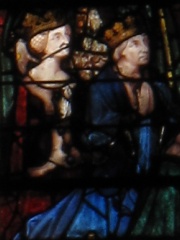
10. Joanna II of Naples (1373 - 1435)
With an HPI of 63.72, Joanna II of Naples is the 10th most famous Croatian Politician. Her biography has been translated into 31 different languages.
Joanna II (25 June 1371 – 2 February 1435) was reigning Queen of Naples from 1414 to her death, when the Capetian House of Anjou became extinct. As a mere formality, she used the title of Queen of Jerusalem, Sicily, and Hungary.
People
Pantheon has 72 people classified as Croatian politicians born between 300 BC and 1997. Of these 72, 23 (31.94%) of them are still alive today. The most famous living Croatian politicians include Kolinda Grabar-Kitarović, Zoran Milanović, and Ivo Josipović. The most famous deceased Croatian politicians include Josip Broz Tito, Diocletian, and Rüstem Pasha. As of April 2024, 12 new Croatian politicians have been added to Pantheon including István Horthy, Ivo Lola Ribar, and Branko Mamula.
Living Croatian Politicians
Go to all RankingsKolinda Grabar-Kitarović
1968 - Present
HPI: 64.02
Zoran Milanović
1966 - Present
HPI: 60.99
Ivo Josipović
1957 - Present
HPI: 59.81
Milan Martić
1954 - Present
HPI: 57.02
Ivo Sanader
1953 - Present
HPI: 56.97
Andrej Plenković
1970 - Present
HPI: 56.69
Josip Manolić
1920 - Present
HPI: 54.62
Lino Červar
1950 - Present
HPI: 51.33
Neven Mimica
1953 - Present
HPI: 49.17
Vesna Pusić
1953 - Present
HPI: 48.96
Dubravka Šuica
1957 - Present
HPI: 48.45
Hrvoje Horvat
1946 - Present
HPI: 48.10
Deceased Croatian Politicians
Go to all RankingsJosip Broz Tito
1892 - 1980
HPI: 83.72
Diocletian
244 - 311
HPI: 81.08
Rüstem Pasha
1500 - 1561
HPI: 74.69
Valens
328 - 378
HPI: 72.51
Franjo Tuđman
1922 - 1999
HPI: 72.15
János Kádár
1912 - 1989
HPI: 70.37
Crispus
305 - 326
HPI: 65.07
Ivan Ribar
1881 - 1968
HPI: 63.87
Joanna II of Naples
1373 - 1435
HPI: 63.72
Tomislav of Croatia
HPI: 63.16
Stjepan Radić
1871 - 1928
HPI: 62.81
Veljko Kadijević
1925 - 2014
HPI: 61.45
Newly Added Croatian Politicians (2024)
Go to all RankingsIstván Horthy
1904 - 1942
HPI: 55.04
Ivo Lola Ribar
1916 - 1943
HPI: 54.82
Branko Mamula
1921 - 2021
HPI: 52.94
Martin Špegelj
1927 - 2014
HPI: 49.84
Helen of Zadar
HPI: 48.31
Jadranko Prlić
1959 - Present
HPI: 46.78
Zlatko Tomčić
1945 - Present
HPI: 46.09
Ödön Gróf
1915 - 1997
HPI: 43.91
Željko Reiner
1953 - Present
HPI: 39.97
Gordan Jandroković
1967 - Present
HPI: 39.72
Perica Bukić
1966 - Present
HPI: 36.26
Tomislav Tomašević
1982 - Present
HPI: 36.20
Overlapping Lives
Which Politicians were alive at the same time? This visualization shows the lifespans of the 25 most globally memorable Politicians since 1700.


